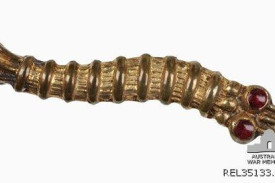General News
8 November, 2025
(Un)lucky clubs of World War II
Whether walking back to safety from behind enemy lines, parachuting out of a disabled aircraft, crashing into water and being saved by a life raft, or enduring horrible burns from a plane crash, the stories of near misses experienced by aircrew during World War II are remarkable.

As a symbol of the camaraderie between the men who had experienced these near misses, numerous clubs were formed, each with a distinct badge or patch to represent the wearer’s exploits.
The following are a few examples of the badges crafted for some of these clubs and some stories of men ‘lucky’ enough to earn themselves membership.
Late Arrivals Club
The Late Arrivals Club or Winged Boot Club honoured those who walked back from behind enemy lines.
Members were awarded certificates with the words “It is never too late to come back”, along with a patch or badge that could be worn on the left breast of a flying suit.
An extract from The Libyan Log by EG Ogilvie (an account of the Empire Air Forces in the Western Desert, July 1941-July 1942) states that the Late Arrivals Club was formed in the summer of 1941 in the desert, but other accounts suggest it originated with staff members of Hobson and Sons (London) Ltd, a firm of civil and military tailors.
The Caterpillar Club
The Caterpillar Club, which was formed in 1922 shortly after Lieutenant Harold Harris made an emergency jump at McCook Field near Dayton, Ohio in the United States, offered membership to tens of thousands during the war who used parachutes made from caterpillar-produced silk to bale out of disabled planes.
The Irvin Air Chute Company awarded unofficial badges in the form of gold caterpillars with red eyes, along with membership certificates.
Other parachutist clubs
This badge is presented to those who qualify for membership of the GQ Parachutists Club by making an emergency descent from aircraft using GQ Parachute Company Ltd equipment.
The centre of the badge depicts a man making a parachute descent while the badge is completed on either side of the parachute by a pair of wings.
The front of the badge bears the letters GQ while on the reverse side appears the inscription “saved my life”.
Each badge presented was numbered in sequence, and on the left-hand reverse side was engraved the name of the person to whom it was presented.
On the right-hand side is engraved the date of his descent.
Roo Club badge and plaque
The gold kangaroo pin badge of the Roo Club was presented to those whose lives had been saved by the use of a Dominion-made parachute.
The silver plaque, depicting a kangaroo making a parachute descent, was inscribed on the reverse side “Presented by Light Aircraft Pty Ltd to [space for name] on qualifying for membership in the Roo Club having made a compulsory bale-out on [space for date] using a Dominion parachute”.
The Goldfish Club
The Goldfish Club (following from the success of the Caterpillar Club) honoured airmen who were rescued after crashing/landing in the sea and taking to their dinghies.
The club wrote: “Money, position or power cannot gain a man or woman entry to the exclusive circles of the Goldfish Club. To become a member, one has to float about upon the sea for a considerable period with nothing but a Carley Rubber Float between one and a watery death.”
The club was founded by the PB Cow and Company of Farnborough, manufacturer of rubber aircraft survival dinghies, and was supported by other makers of aircrew rescue dinghies.
Each wavy line was meant to represent the number of times an airman relied on a dinghy for survival.
Originally, it was intended to produce a metal badge but metal could not be secured and, due to wartime fabric rationing restrictions, the patches were embroidered on material taken from old dinner suits donated by staff from PB Cow and Co Ltd.
The Guinea Pig Club
The Guinea Pig Club was started by aircrew who had been horribly burned and disfigured in the Battle of Britain and were treated by innovative surgeon Sir Archibald McIndoe at Queen Victoria’s Hospital in East Grinstead, West Sussex.
Immobilised for weeks and recovering for months, the men in McIndoe’s ward started a drinking club, helped by the free beer given to them during their recovery.
The men decided to call themselves The Guinea Pig Club as they were all, in some way, test subjects of new techniques.
Between the club’s establishment in July 1941 and its disbanding in 1945 it welcomed 649 members.
Of those, at least 19 were Australians.
The Guinea Pig Club held reunions over decades to celebrate their incredible recoveries and honour the man who made it possible.
The last was held in East Grinstead in 2007.
With thanks: Sally Bertram, RSL Military History Library. Contact Sally at sj.bertram@hotmail.com or call 0409 351 940.





